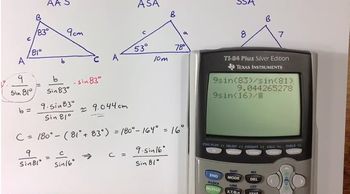Table of contents
- 0. Review of College Algebra4h 43m
- 1. Measuring Angles39m
- 2. Trigonometric Functions on Right Triangles2h 5m
- 3. Unit Circle1h 19m
- 4. Graphing Trigonometric Functions1h 19m
- 5. Inverse Trigonometric Functions and Basic Trigonometric Equations1h 41m
- 6. Trigonometric Identities and More Equations2h 34m
- 7. Non-Right Triangles1h 38m
- 8. Vectors2h 25m
- 9. Polar Equations2h 5m
- 10. Parametric Equations1h 6m
- 11. Graphing Complex Numbers1h 7m
7. Non-Right Triangles
Law of Sines
Problem 7.37
Textbook Question
The bearing of a lighthouse from a ship was found to be N 37° E. After the ship sailed 2.5 mi due south, the new bearing was N 25° E. Find the distance between the ship and the lighthouse at each location.
 Verified step by step guidance
Verified step by step guidance1
<Step 1: Understand the problem setup. The initial bearing of the lighthouse from the ship is N 37° E, which means the lighthouse is 37° east of due north from the ship's position.>
<Step 2: After the ship sails 2.5 miles due south, the new bearing to the lighthouse is N 25° E. This means the lighthouse is now 25° east of due north from the ship's new position.>
<Step 3: Visualize the problem as a triangle. The ship's initial and final positions, along with the lighthouse, form a triangle. The side of the triangle between the two ship positions is 2.5 miles.>
<Step 4: Use the Law of Sines or Law of Cosines to find the distances. You can use the angles and the known side to find the other sides of the triangle, which represent the distances from the ship to the lighthouse at each position.>
<Step 5: Calculate the angles within the triangle. The angle at the lighthouse can be found using the difference in bearings (37° - 25° = 12°). Use this angle and the known side to solve for the other sides using trigonometric laws.>
Recommended similar problem, with video answer:
 Verified Solution
Verified SolutionThis video solution was recommended by our tutors as helpful for the problem above
Video duration:
0m:0sPlay a video:
Was this helpful?
Key Concepts
Here are the essential concepts you must grasp in order to answer the question correctly.
Bearing
Bearing is a method of describing direction using angles measured clockwise from the north. In this context, bearings are given in degrees, with 'N' indicating north and 'E' indicating east. For example, a bearing of N 37° E means the direction is 37 degrees east of due north.
Trigonometric Functions
Trigonometric functions, such as sine, cosine, and tangent, relate the angles of a triangle to the lengths of its sides. These functions are essential for solving problems involving right triangles, especially when determining distances and angles in navigation and bearing calculations.
Recommended video:

Introduction to Trigonometric Functions
Law of Cosines
The Law of Cosines is a formula used to find a side or angle in any triangle when two sides and the included angle are known, or when all three sides are known. It is particularly useful in non-right triangles, allowing for the calculation of distances between points based on their bearings and the angles formed.
Recommended video:

Intro to Law of Cosines

 4:27m
4:27mWatch next
Master Intro to Law of Sines with a bite sized video explanation from Patrick Ford
Start learningRelated Videos
Related Practice


















